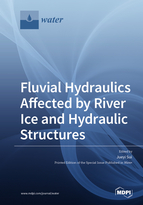Fluvial Hydraulics Affected by River Ice and Hydraulic Structures
A special issue of Water (ISSN 2073-4441). This special issue belongs to the section "Hydraulics and Hydrodynamics".
Deadline for manuscript submissions: closed (31 October 2021) | Viewed by 30167
Special Issue Editor
Interests: local scour; sediment transport; river ice hydraulics; fluvial hydraulics; vegetated channel; snow hydrology
Special Issues, Collections and Topics in MDPI journals
Special Issue Information
Dear Colleagues,
To date, scientists conducted lots of cutting-edge research on all aspects of fluvial hydraulics interpreted in its widest sense. So many research has been published to explore the fluvial hydraulics in the presence of hydraulic structures such as bridge piers. In winter, the formation of ice cover in rivers is an important phenomenon that affects fluvial hydraulics compared to that under open flow conditions. Consequently, the winter operation of ice-covered rivers must be changed. In the past 30 years, with the growing interest in fluvial hydraulics under ice-covered flow conditions, some progress has been made. However, a more comprehensive understanding of the impact of ice cover on fluvial hydraulics is required. The aim of this Special Issue is to seek research works that improve knowledge of sediment transport, local scour around hydraulic structures, and fluvial processes under ice-covered flow conditions. It will include not only the mechanics of sediment transport in natural rivers and laboratory flumes but also what is related to local scour and fluvial processes under both open channel and ice-covered flow conditions. Research work regarding the environmental and ecological impacts of sedimentation, interaction between river ice and riverbed deformation, and the effect of reservoir sedimentation and coastal erosion will also be included.
Dr. Jueyi Sui
Guest Editor
Manuscript Submission Information
Manuscripts should be submitted online at www.mdpi.com by registering and logging in to this website. Once you are registered, click here to go to the submission form. Manuscripts can be submitted until the deadline. All submissions that pass pre-check are peer-reviewed. Accepted papers will be published continuously in the journal (as soon as accepted) and will be listed together on the special issue website. Research articles, review articles as well as short communications are invited. For planned papers, a title and short abstract (about 100 words) can be sent to the Editorial Office for announcement on this website.
Submitted manuscripts should not have been published previously, nor be under consideration for publication elsewhere (except conference proceedings papers). All manuscripts are thoroughly refereed through a single-blind peer-review process. A guide for authors and other relevant information for submission of manuscripts is available on the Instructions for Authors page. Water is an international peer-reviewed open access semimonthly journal published by MDPI.
Please visit the Instructions for Authors page before submitting a manuscript. The Article Processing Charge (APC) for publication in this open access journal is 2600 CHF (Swiss Francs). Submitted papers should be well formatted and use good English. Authors may use MDPI's English editing service prior to publication or during author revisions.
Keywords
- flooding
- fluvial hydraulics
- ice cover
- ice jam
- local scour
- riverbed deformation
- river ice hydraulics
- sediment transport






